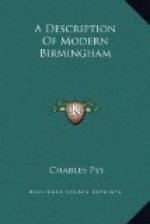To demonstrate what has been advanced respecting the salubrity of the air and purity of the water, the hotel, in Temple-row, was erected in the year 1772, upon the tontine principle. There being fifty shares, of course the same number of lives must be nominated at that time, of whom there were, in the middle of October, 1818, forty-five still living.
Another instance may be adduced, equally appropriate. There are at the present time, 1818, still living, and in health, seventeen persons, (and there may be several more), who all of them received their education under one schoolmaster, the youngest of whom is sixty-nine years of age.
And what is still more remarkable, although there were in the middle of November more than three hundred and eighty children in the asylum, there was not one sick person in that numerous family.
ST. MARTIN’s CHURCH
Is undoubtedly of great antiquity, and to trace its foundation is at present impossible, tradition itself not giving any clue. It was originally erected with stone, but the exterior being decayed by time, in the year 1690 the body of the church, and also the tower, were cased with bricks of an admirable quality, and mortar suitable to them, for at this time there is scarcely any symptoms of decay. The elegant spire has been several times injured by lightning, and during its repairs the workmen have contracted the length of it considerably. It was at one time (whatever it is now) the loftiest spire in the kingdom, measuring from its base to the weathercock. The person who repaired it in 1777 made the observation.—There are, no doubt, several steeples more lofty, measuring from the ground, the towers of which extend to a great height, whilst this at Birmingham is very low.—There are within the church two marble monuments, with recumbent figures upon them, but no inscription, and are, like the church, of such ancient date, that no person has yet presumed to say when they were executed nor for whom, (only by conjecture); but let the artists be who they would, the effigies do them great credit, and were highly deserving of better treatment than they have experienced. In the church is a fine-toned organ. In the steeple are twelve musical bells, and a set of chimes, that play with great accuracy a different tune every day in the week, at the hour of three, six, nine and twelve; and they are so contrived, that they shift from one tune to another, by means of their own machinery. On the south side of the tower there is a meridian line, which was affixed there by Ferguson, the astronomer, so that when the sun shines, the hour of twelve may be ascertained to a certainty. Birmingham is only one parish, except for church fees, and in that respect, the rector of St. Philip’s presides over a small part within the town. The Rev. Charles Curtis is rector of Birmingham: the Rev. Edmund Outram being rector of St. Philip’s, in Birmingham. The regimental colours, late belonging to the Loyal Birmingham Association, are suspended in the east window, over the altar. This church is computed to accommodate 2200 persons.




